Deck 14: Waves
Question
Question
Question
Question
Question
Question
Question
Question
Question
Question
Question
Question
Question
Question
Question
Question
Question
Question
Question
Question
Question
Question
Question
Question
Question
Question
Question
Question
Question
Question
Question
Question
Question
Question
Question
Question
Question
Question
Question
Question

Unlock Deck
Sign up to unlock the cards in this deck!
Unlock Deck
Unlock Deck
1/40
Play
Full screen (f)
Deck 14: Waves
1
Which of these statements can be correctly applied to a wave?
A)Its motion results in the flow of material.
B)Its motion in a medium transfers mass and energy.
C)Its motion in a medium transfers energy.
D)They all require a medium in which to propagate.
A)Its motion results in the flow of material.
B)Its motion in a medium transfers mass and energy.
C)Its motion in a medium transfers energy.
D)They all require a medium in which to propagate.
Its motion in a medium transfers energy.
2
Figure 14.3 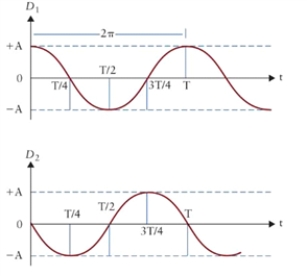 The figure shows two waves.
The figure shows two waves.
Two identical waves are in interference. The resultant amplitude will be zero if the phase difference between the waves is __________.
A)2ð
B)ð
C)ð/2
D)ð/4
 The figure shows two waves.
The figure shows two waves.Two identical waves are in interference. The resultant amplitude will be zero if the phase difference between the waves is __________.
A)2ð
B)ð
C)ð/2
D)ð/4
ð
3
Figure 14.4  Fig. 14.4 shows a standing wave.
Fig. 14.4 shows a standing wave.
A cello C-string vibrates in its fundamental mode with a frequency of 65 Hz. What is the frequency of the harmonic in Fig. 14.4?
A)22 Hz
B)130 Hz
C)195 Hz
D)260 Hz
 Fig. 14.4 shows a standing wave.
Fig. 14.4 shows a standing wave.A cello C-string vibrates in its fundamental mode with a frequency of 65 Hz. What is the frequency of the harmonic in Fig. 14.4?
A)22 Hz
B)130 Hz
C)195 Hz
D)260 Hz
195 Hz
4
Which of the following equations represents a wave function moving to the right (+x-direction)?
A)y(x, t) = x + 4.0t
B)y(x, t) = (20.0t + x)2
C)y(x, t) = x - 4.0t
D)y(x, t) = (x + 2.0t)2
A)y(x, t) = x + 4.0t
B)y(x, t) = (20.0t + x)2
C)y(x, t) = x - 4.0t
D)y(x, t) = (x + 2.0t)2

Unlock Deck
Unlock for access to all 40 flashcards in this deck.
Unlock Deck
k this deck
5
The vibration of a piano's A-string produces a wave with a wavelength of ë = 78 cm, and propagates with a speed of 343 m/s. What is the frequency?
A)0.44 Hz
B)4.40 Hz
C)44.0 Hz
D)440 Hz
A)0.44 Hz
B)4.40 Hz
C)44.0 Hz
D)440 Hz

Unlock Deck
Unlock for access to all 40 flashcards in this deck.
Unlock Deck
k this deck
6
Which of these waves can experience interference?
A)only sinusoidal waves
B)only longitudinal waves
C)only electromagnetic waves
D)all types of waves
A)only sinusoidal waves
B)only longitudinal waves
C)only electromagnetic waves
D)all types of waves

Unlock Deck
Unlock for access to all 40 flashcards in this deck.
Unlock Deck
k this deck
7
A string is under tension. You release the tension to half its previous value. The frequency of the first harmonic
A)decreases by a factor of .
.
B)increases by factor of 2.
C)does not change, but wavelength reduces to half.
D)decreases by a factor of 4.
A)decreases by a factor of
 .
.B)increases by factor of 2.
C)does not change, but wavelength reduces to half.
D)decreases by a factor of 4.

Unlock Deck
Unlock for access to all 40 flashcards in this deck.
Unlock Deck
k this deck
8
A wave on a string is represented by the wave function y(x, t) = Asin(kx - ùt). When it reflects at a loose end, what is the wave function of the reflected wave?
A)y(x, t) = Asin(kx - ùt)
B)y(x, t) = -Asin(kx + ùt)
C)y(x, t) = Asin(kx + ùt)
D)y(x, t) = -Asin(kx - ùt)
A)y(x, t) = Asin(kx - ùt)
B)y(x, t) = -Asin(kx + ùt)
C)y(x, t) = Asin(kx + ùt)
D)y(x, t) = -Asin(kx - ùt)

Unlock Deck
Unlock for access to all 40 flashcards in this deck.
Unlock Deck
k this deck
9
Figure 14.3  The figure shows two waves.
The figure shows two waves.
What additional phase difference between the waves in Fig. 14.3 would be needed for the interference of the two waves to be destructive?
A)2ð
B)3ð/2
C)ð
D)ð/2
 The figure shows two waves.
The figure shows two waves.What additional phase difference between the waves in Fig. 14.3 would be needed for the interference of the two waves to be destructive?
A)2ð
B)3ð/2
C)ð
D)ð/2

Unlock Deck
Unlock for access to all 40 flashcards in this deck.
Unlock Deck
k this deck
10
See Fig. 14.4. For a typical high E guitar string with frequency f = 329.6 Hz, what is the ratio between the tensions when it is tuned to the fundamental tone, Tf, and when it is tuned to harmonic, Th?
A)1/3
B)1/
C)
D)3
A)1/3
B)1/

C)

D)3

Unlock Deck
Unlock for access to all 40 flashcards in this deck.
Unlock Deck
k this deck
11
Which of the following equations represents a wave function moving to the left (-x-direction)?
A)y(x, t) = x - 4.0t
B)y(x, t) = (-20.0t + x)2
C)y(x, t) = x + 4.0t
D)y(x, t) = (x - 2.0t)2
A)y(x, t) = x - 4.0t
B)y(x, t) = (-20.0t + x)2
C)y(x, t) = x + 4.0t
D)y(x, t) = (x - 2.0t)2

Unlock Deck
Unlock for access to all 40 flashcards in this deck.
Unlock Deck
k this deck
12
![<strong> Figure 14.1 The figure shows a wave. The wave from Fig. 14.1 is moving at a speed of 5 cm/s. If L<sub>1</sub> = 6 cm and L<sub>2</sub> = 5 cm, which wave equation describes the wave?</strong> A)y(x, t) = (6 cm)sin[(6.28 s<sup>-1</sup>)t - (1.05 cm<sup>-1</sup>)x)] B)y(x, t) = (3 cm)sin[(12.6 s<sup>-1</sup>)t - (0.63 cm<sup>-1</sup>)x)] C)y(x, t) = (3 cm)sin[(6.28 s<sup>-1</sup>)t - (1.05 cm<sup>-1</sup>)x)] D)y(x, t) = (6 cm)sin[(3.76 s<sup>-1</sup>)t - (2.09 cm<sup>-1</sup>)x)]](https://d2lvgg3v3hfg70.cloudfront.net/TB8418/11eb7f12_ec86_1127_bc0b_9768342dc077_TB8418_00.jpg) Figure 14.1
Figure 14.1 ![<strong> Figure 14.1 The figure shows a wave. The wave from Fig. 14.1 is moving at a speed of 5 cm/s. If L<sub>1</sub> = 6 cm and L<sub>2</sub> = 5 cm, which wave equation describes the wave?</strong> A)y(x, t) = (6 cm)sin[(6.28 s<sup>-1</sup>)t - (1.05 cm<sup>-1</sup>)x)] B)y(x, t) = (3 cm)sin[(12.6 s<sup>-1</sup>)t - (0.63 cm<sup>-1</sup>)x)] C)y(x, t) = (3 cm)sin[(6.28 s<sup>-1</sup>)t - (1.05 cm<sup>-1</sup>)x)] D)y(x, t) = (6 cm)sin[(3.76 s<sup>-1</sup>)t - (2.09 cm<sup>-1</sup>)x)]](https://d2lvgg3v3hfg70.cloudfront.net/TB8418/11eb7f12_ec86_1128_bc0b_55d2c7e6102a_TB8418_00.jpg)
The figure shows a wave.
The wave from Fig. 14.1 is moving at a speed of 5 cm/s. If L1 = 6 cm and L2 = 5 cm, which wave equation describes the wave?
A)y(x, t) = (6 cm)sin[(6.28 s-1)t - (1.05 cm-1)x)]
B)y(x, t) = (3 cm)sin[(12.6 s-1)t - (0.63 cm-1)x)]
C)y(x, t) = (3 cm)sin[(6.28 s-1)t - (1.05 cm-1)x)]
D)y(x, t) = (6 cm)sin[(3.76 s-1)t - (2.09 cm-1)x)]

Unlock Deck
Unlock for access to all 40 flashcards in this deck.
Unlock Deck
k this deck
13
Figure 14.2 ![<strong>Figure 14.2 The figure shows a wave in a rope with two points labelled A and B. A harmonic wave travelling along the x-axis is described by the equation y(x, t) = (4 cm)sin[(0.5 cm)x - (1.05 s<sup>-1</sup>)t)]. What is the wavelength of the wave?</strong> A)0.5 cm B)1.05 cm C)4.0 cm D)12.6 cm](https://d2lvgg3v3hfg70.cloudfront.net/TB8418/11eb7f12_ec86_3839_bc0b_8599551e7b85_TB8418_00.jpg) The figure shows a wave in a rope with two points labelled A and B.
The figure shows a wave in a rope with two points labelled A and B.
A harmonic wave travelling along the x-axis is described by the equation y(x, t) = (4 cm)sin[(0.5 cm)x - (1.05 s-1)t)]. What is the wavelength of the wave?
A)0.5 cm
B)1.05 cm
C)4.0 cm
D)12.6 cm
![<strong>Figure 14.2 The figure shows a wave in a rope with two points labelled A and B. A harmonic wave travelling along the x-axis is described by the equation y(x, t) = (4 cm)sin[(0.5 cm)x - (1.05 s<sup>-1</sup>)t)]. What is the wavelength of the wave?</strong> A)0.5 cm B)1.05 cm C)4.0 cm D)12.6 cm](https://d2lvgg3v3hfg70.cloudfront.net/TB8418/11eb7f12_ec86_3839_bc0b_8599551e7b85_TB8418_00.jpg) The figure shows a wave in a rope with two points labelled A and B.
The figure shows a wave in a rope with two points labelled A and B.A harmonic wave travelling along the x-axis is described by the equation y(x, t) = (4 cm)sin[(0.5 cm)x - (1.05 s-1)t)]. What is the wavelength of the wave?
A)0.5 cm
B)1.05 cm
C)4.0 cm
D)12.6 cm

Unlock Deck
Unlock for access to all 40 flashcards in this deck.
Unlock Deck
k this deck
14
Two ropes, A and B, are tied and stretched. Rope A has a linear mass density 9 times higher than rope B. A pulse travels in rope A and continues in B. The speed of the pulse in rope A is vA, and in rope B it is vB. What is the relationship between the speeds?
A)vB = 9vA
B)vB = 3vA
C)vA = 9vB
D)vA = 3vB
A)vB = 9vA
B)vB = 3vA
C)vA = 9vB
D)vA = 3vB

Unlock Deck
Unlock for access to all 40 flashcards in this deck.
Unlock Deck
k this deck
15
Figure 14.3  The figure shows two waves.
The figure shows two waves.
What is the phase difference, ÄÖ, between the two waves in Fig. 14.3?
A)2ð
B)3ð/2
C)ð
D)ð/2
 The figure shows two waves.
The figure shows two waves.What is the phase difference, ÄÖ, between the two waves in Fig. 14.3?
A)2ð
B)3ð/2
C)ð
D)ð/2

Unlock Deck
Unlock for access to all 40 flashcards in this deck.
Unlock Deck
k this deck
16
Figure 14.2  The figure shows a wave in a rope with two points labelled A and B.
The figure shows a wave in a rope with two points labelled A and B.
A harmonic wave is travelling to the right on a long, stretched rope. Two points on the rope are labelled A and B (see Fig. 14.2). When the wave moves a little to the right, how do these two points move?
A)Both A and B move to the right.
B)Point A moves to the right and B to the left.
C)Point A moves down and B up.
D)Point A moves up and B down.
 The figure shows a wave in a rope with two points labelled A and B.
The figure shows a wave in a rope with two points labelled A and B.A harmonic wave is travelling to the right on a long, stretched rope. Two points on the rope are labelled A and B (see Fig. 14.2). When the wave moves a little to the right, how do these two points move?
A)Both A and B move to the right.
B)Point A moves to the right and B to the left.
C)Point A moves down and B up.
D)Point A moves up and B down.

Unlock Deck
Unlock for access to all 40 flashcards in this deck.
Unlock Deck
k this deck
17
Which wave does NOT belong to the group?
A)infrared
B)ultraviolet
C)ultrasound
D)X-rays
A)infrared
B)ultraviolet
C)ultrasound
D)X-rays

Unlock Deck
Unlock for access to all 40 flashcards in this deck.
Unlock Deck
k this deck
18
String with fixed ends can vibrate in several modes (harmonics). How does the length of a string relate to wavelengths of harmonics?
A)The length of a string contains an integer number of full wavelengths.
B)The length of a string contains an integer number of half wavelengths.
C)The length of a string contains only an odd number of full wavelengths.
D)The length of a string contains only an odd number of half wavelengths.
A)The length of a string contains an integer number of full wavelengths.
B)The length of a string contains an integer number of half wavelengths.
C)The length of a string contains only an odd number of full wavelengths.
D)The length of a string contains only an odd number of half wavelengths.

Unlock Deck
Unlock for access to all 40 flashcards in this deck.
Unlock Deck
k this deck
19
If the speed of a wave increases, how would one of these other parameters change?
A)wavelength increases
B)period increases
C)frequency decreases
D)amplitude increases
A)wavelength increases
B)period increases
C)frequency decreases
D)amplitude increases

Unlock Deck
Unlock for access to all 40 flashcards in this deck.
Unlock Deck
k this deck
20
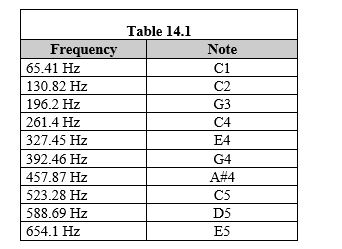 Figure 14.1
Figure 14.1 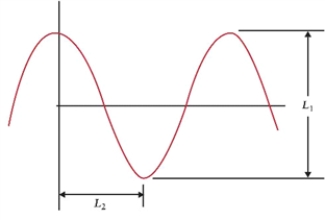
The figure shows a wave.
If L2 = 65.5 cm, which note from Table 14.1 is represented in Fig. 14.1? Assume that the speed of sound is 343 m/s.
A)G3
B)C4
C)G4
D)C5

Unlock Deck
Unlock for access to all 40 flashcards in this deck.
Unlock Deck
k this deck
21
Two identical waves (having the same wavelength and amplitude) interfere with each other. The initial amplitude of each wave was 28 cm; the resultant wave has an amplitude of 12 cm. What is the phase difference between the waves represented as a fraction of a wavelength?

Unlock Deck
Unlock for access to all 40 flashcards in this deck.
Unlock Deck
k this deck
22
Which note is represented by the wave equation y(x, t) = 2sin[(1642 s-1)t - (4.79 m-1)x? For reference, use Table 14.1.

Unlock Deck
Unlock for access to all 40 flashcards in this deck.
Unlock Deck
k this deck
23
A reflected wave on a fixed end is inverted, but does not change shape. A reflected wave on a loose end is not inverted, nor does it change shape.

Unlock Deck
Unlock for access to all 40 flashcards in this deck.
Unlock Deck
k this deck
24
Figure 14.5
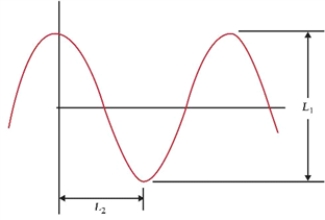
Fig. 14.5 shows a sound wave.
Fig. 14.5 shows a sound wave in the air. L1 = 200 ìPa, L2 = 52.4 cm. Which note from Table 14.1 is represented? What is the amplitude of the wave? Take the speed of sound in the air as 343 m/s.

Fig. 14.5 shows a sound wave.
Fig. 14.5 shows a sound wave in the air. L1 = 200 ìPa, L2 = 52.4 cm. Which note from Table 14.1 is represented? What is the amplitude of the wave? Take the speed of sound in the air as 343 m/s.

Unlock Deck
Unlock for access to all 40 flashcards in this deck.
Unlock Deck
k this deck
25
For waves moving at a given speed, the frequency is higher if the wavelength is smaller.

Unlock Deck
Unlock for access to all 40 flashcards in this deck.
Unlock Deck
k this deck
26
The length of a string contains an integer number of halves of wavelengths of harmonics.

Unlock Deck
Unlock for access to all 40 flashcards in this deck.
Unlock Deck
k this deck
27
The frequency of a wave is determined by the source of the wave, but wavelength is not. Wavelength depends on the medium through which the wave propagates.

Unlock Deck
Unlock for access to all 40 flashcards in this deck.
Unlock Deck
k this deck
28
The wave described by the equation y(x, t) = (4 cm)sin[(0.5 cm)x + (1.05 s-1)t)] is moving along the x-axis in the positive direction (to the right).

Unlock Deck
Unlock for access to all 40 flashcards in this deck.
Unlock Deck
k this deck
29
When a wave passes through a certain medium, the particles of the medium move with the wave. For example, a sound wave propagates through air via air molecules that move from the source to receiver.

Unlock Deck
Unlock for access to all 40 flashcards in this deck.
Unlock Deck
k this deck
30
Bats use ultrasound to locate prey. The wavelength of sound has to be of the order of size of the prey if the prey is to be detected. What is the size of the smallest insect a bat can detect if it emits a sound at 55 kHz? The speed of sound is 343 m/s.

Unlock Deck
Unlock for access to all 40 flashcards in this deck.
Unlock Deck
k this deck
31
Constructive interference occurs only when two harmonious waves arrive at the same point with a phase difference of exactly 1 wavelength.

Unlock Deck
Unlock for access to all 40 flashcards in this deck.
Unlock Deck
k this deck
32
Figure 14.6 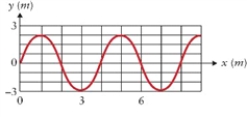 Fig. 14.6 shows a sound wave.
Fig. 14.6 shows a sound wave.
What is the amplitude of the wave represented in Fig. 14.6? What are the wavelength and the frequency, assuming that it is a sound wave in air? The speed of sound in air is 343 m/s.
 Fig. 14.6 shows a sound wave.
Fig. 14.6 shows a sound wave.What is the amplitude of the wave represented in Fig. 14.6? What are the wavelength and the frequency, assuming that it is a sound wave in air? The speed of sound in air is 343 m/s.

Unlock Deck
Unlock for access to all 40 flashcards in this deck.
Unlock Deck
k this deck
33
Figure 14.5

Fig. 14.5 shows a sound wave.
Fig. 14.5 shows a sound wave in the water. L1 = 220 ìPa, L2 = 226 cm. Which note from Table 14.1 is represented? What is the amplitude of the wave? Take the speed of sound in the water as 1482 m/s.

Fig. 14.5 shows a sound wave.
Fig. 14.5 shows a sound wave in the water. L1 = 220 ìPa, L2 = 226 cm. Which note from Table 14.1 is represented? What is the amplitude of the wave? Take the speed of sound in the water as 1482 m/s.

Unlock Deck
Unlock for access to all 40 flashcards in this deck.
Unlock Deck
k this deck
34
Describe the difference between reflected waves in these two cases: when the incident wave propagates from a less dense medium to a denser medium, and the opposite case, when the incident wave propagates from a denser medium to a less dense medium.

Unlock Deck
Unlock for access to all 40 flashcards in this deck.
Unlock Deck
k this deck
35
When a wave passes through a certain medium, the particles of the medium move with the wave. For example, a sound wave propagates through air via air molecules, which move from the source to receiver.

Unlock Deck
Unlock for access to all 40 flashcards in this deck.
Unlock Deck
k this deck
36
Whenever a wave reflects off the boundary between denser and less dense medium, in any direction, it will result in an inverted wave.

Unlock Deck
Unlock for access to all 40 flashcards in this deck.
Unlock Deck
k this deck
37
An antenna 72.8 m long has a length equal to ¼ of a wavelength of the produced wave. If the station using this antenna emits a signal of 1030 kHz, what is the speed of the wave?

Unlock Deck
Unlock for access to all 40 flashcards in this deck.
Unlock Deck
k this deck
38
If we add two sine waves at the same point in space, the resultant has to have a larger amplitude than either of individual waves.

Unlock Deck
Unlock for access to all 40 flashcards in this deck.
Unlock Deck
k this deck
39
A cello C-string vibrates in its fundamental mode with a frequency of 60 Hz. In order to tune it to a proper frequency of 65 Hz, how do you adjust the tension?

Unlock Deck
Unlock for access to all 40 flashcards in this deck.
Unlock Deck
k this deck
40
Figure 14.6  Fig. 14.6 shows a sound wave.
Fig. 14.6 shows a sound wave.
What is the amplitude of the wave represented in Fig. 14.6? What are the wavelength and the frequency, assuming that it is a radio wave? The speed of the radio wave is 3 × 108 m/s.
 Fig. 14.6 shows a sound wave.
Fig. 14.6 shows a sound wave.What is the amplitude of the wave represented in Fig. 14.6? What are the wavelength and the frequency, assuming that it is a radio wave? The speed of the radio wave is 3 × 108 m/s.

Unlock Deck
Unlock for access to all 40 flashcards in this deck.
Unlock Deck
k this deck



